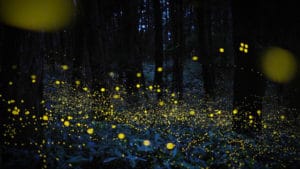 A project that sparked widespread interest and a successful science crowdsourcing campaign has inspired an international collaboration that produced two high-quality reference genomes, as well as a draft genome of a related beetle. And the results have shed light on the evolution of bioluminescence.
A project that sparked widespread interest and a successful science crowdsourcing campaign has inspired an international collaboration that produced two high-quality reference genomes, as well as a draft genome of a related beetle. And the results have shed light on the evolution of bioluminescence.
We’ve been following the progress of Team Firefly since the team of scientists from MIT, University of Rochester, Brigham Young University, Indiana University, Cornell University, and Tufts University narrowly lost our 2016 SMRT Grant competition. The project to sequence the genome of the Big Dipper Firefly, Photinus pyralis, was ultimately crowdfunded through the Experiment site and our Genome Galaxy Initiative.
In its latest update, the team announced it joined forces with collaborators around the globe to add two additional genomes to the fold: the Japanese “Heike” firefly, Aquatica lateralis, and the bioluminescent click-beetle, or “cucubano”, Ignelater luminosus.
The re-named Team Bioluminescent Beetles offered a sneak peek into its results by publishing a pre-print on the bioRxiv service, “Firefly genomes illuminate the origin and evolution of bioluminescence.” The scientists have also made the genome data downloadable at http://www.fireflybase.org.
“One of most intriguing findings of our results so far is that we think that fireflies and click-beetles actually evolved their very similar bioluminescent systems independently, making beetle bioluminescence a possible new example of parallel evolution,” writes team member Tim Fallon, of the Whitehead Institute for Biomedical Research at MIT.
The data also provide insight into the evolution of other traits, including chemical defenses and the viral and microbial holobiome associated with the unique lifestyle of bioluminescent beetles.
Until now, scientists have been in the dark about the genes behind the firefly luciferase gene, which are widely used in agricultural and biomedical research. The team hopes its findings could help in the improvement of these engineered bioluminescent systems, and also aid species conservation efforts.
Interested in pitching your own genome sequencing project? We are partnering with our certified service provider GENEWIZ to offer a ‘Sequence the Tree of Life’ SMRT Grant program. Submit your proposal for a chance to win sequencing on the Sequel System by March 25.